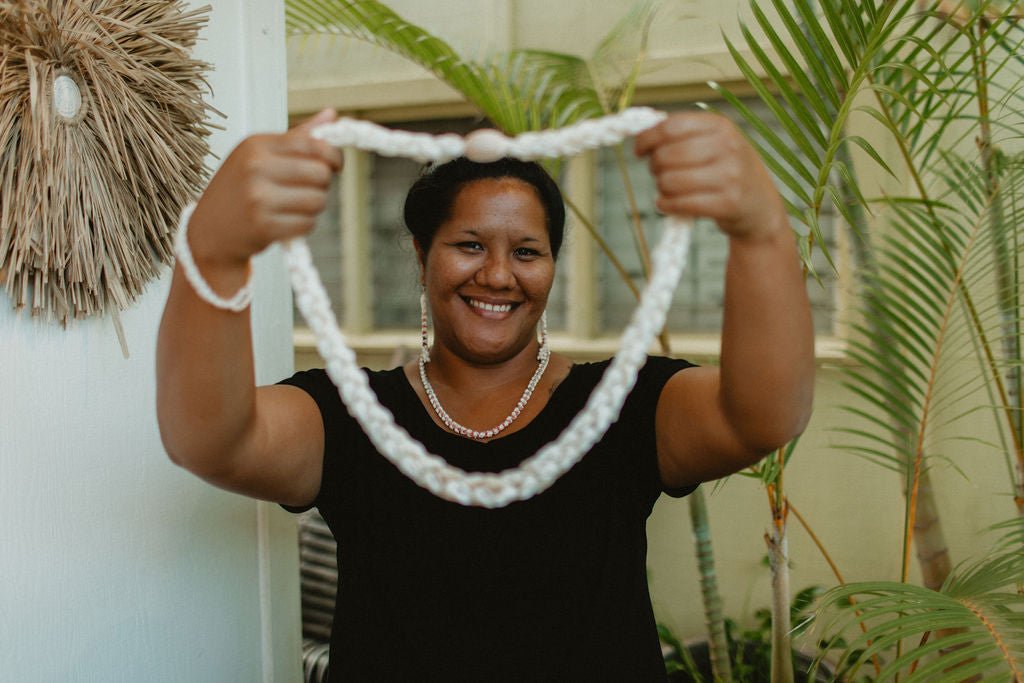Pua Kanahele: Kauaʻi Niʻihau Shell Artist
December 16, 2023 – Haylin Chock

ʻŌlelo Noʻeau #1200
ʻIke aku,ʻike mai, kōkua aku kōkua mai; pēlā ihola ka nohona 'ohana.
Translation: Recognize and be recognized, help and be helped; such is family life. Family life requires an exchange of mutual help and recognition.
The sun rises over the Kauaʻi mountains, and through a soft ocean morning mist, Niʻihau o Kahelelani rises out of the horizon at Kekaha beach. In the sleepy neighborhoods of Kekaha, Kauaʻi, and (Annie-Allen Marie keoaloha puaokalani) or Pua Kanahele resides with her 'ohana. Pua is a mother of two and a fifth-generation Niʻihau shell artist. She was raised between Kauaʻi and Niʻihau, the island of her kupuna. Niʻihau shell jewelry are highly coveted works of art created by the people of Niʻihau. Puaʻs 'ohana has passed down the skill of stringing the various shells of Niʻihau into intricate necklaces and earrings.
Niʻihau, also known as Niʻihau o Kahelelani, is the northernmost inhabited land mass in the Hawaiian island chain. Kahelelani is the name of a Chief who ruled over the island during a prosperous time for the Niʻihau people. He is also the namesake of one of the shells used in lei pūpū. Some commonly used pūpū are the Momi, Lāiki, and Kahelelani. Shells are generally identified by classifying them as a type of shell and then adding any qualifying terms, usually relating to color. Some Common colors are ke'oke'o (white), 'ākala (pink), lenalena (yellow), and 'ōma'oma'o (green). Shades of colors are often classified as 'āhiehie (light) or ikaika (dark). A few other terms include kahakaha (striped), 'ōnikiniki (spotted), 'āpu'upu'u (bumpy), and even waha'ula'ula (red mouth).
These works of art are so coveted for the beauty of the shells and for the hours of craftsmanship that go into even the most minor pieces. Some styles of lei take years to perfect. Even at a master level, some styles are so meticulous it takes years to complete a single project. The most intricate styles are Kipona, Poepoe, Pikake, Heliconia, or Kalaunu. Many styles of stringing are named after types of flowers, and this is because the shells are considered the "Flower" of Niʻihau. Like other islands are associated with a color and flower, Kauaʻi is purple and the mokihana berry. Niʻihau is known for its shells and is related to the color light blue. Niʻihau is naturally arid, making it difficult for many native plants to grow. Still, the shells found there are more vibrant than others found further down the island chain.
Pua grew up watching her mother make lei pūpū. She can recall their long days at the beaches on Niʻihau, picking shells and swimming with her ʻohana.
"Some of my fondest memories growing up was the adventure of looking for the shells. There are no roads or cars in Niʻihau. To get to the beaches with shells, we either had to walk, ride a bike, or ride a horse. Just getting to the spot was a challenge in itself. Once we were there, We would spend the whole day looking for shells, jumping in the ocean to cool off, and on especially calm days, we could even dive for some shells. These were some of the fondest memories that connect me back to days spent with my mother. In a way, the time I spend collecting and making lei pūpū directly connects to my relationship with my mom. When I make lei pūpū, it's like a memory I can physically touch, making me want to do it more."
For a time, Niʻihau families were the only artists making lei pūpū. Still, today, there are jewelers and artists from around the world who have learned either from a master or a workshop and are also selling Niʻihau shell jewelry. With so many options and different artists, Customers may ask, "What makes lei pūpū from Niʻihau, from people like Pua and her 'ohana special?"
Pua shares, "There are so many talented and skilled artists out there now, so I'm grateful when someone chooses to support me or one of my family members. Each piece of jewelry I craft is an extension of my heart. All those fond memories of my family and Niʻihau go into my work. Sometimes, we even have gatherings with the whole 'ohana and make things together. All the laughs and good times between us are going into the pieces we make. If people choose to support one of us, we are all being supported. Through every sale, my 'ohana and I can keep making a living here, and it keeps us close to Kauaʻi and Niʻihau; close to each other. By supporting Niʻihau artists, the customers can help us maintain our way of life, allowing us to stay connected to our culture and each other."

You can find some Puaʻs pieces at the Work It Out boutique in Kapaʻa this holiday season. She has something for all tastes. Whether you're looking for a mommy and me matching studs or something extra special like a colorful lei pūpū in the pikake style. You can check it out in-store now.
Note from the author:
After interviewing Pua, we closed with the question, "Why are Niʻihau shells such a special gift to receive?" she answered by gifting me a pair of 1-inch heliconia-style earrings. I was overwhelmed with gratitude for being able to hear her stories and being gifted a piece of those memories. To receive Niʻihau shells is a gift beyond words. The chance to know a little about the artist and share her stories is now intertwined with a new memory we created. In reflection of other projects and lei pūpū I have been gifted, Each is a significant memory I made and hold dear to my heart. The best part of receiving pūpū is the beauty in the memories you create giving and receiving it.
